| Article ID | Journal | Published Year | Pages | File Type |
|---|---|---|---|---|
| 8052405 | Applied Mathematical Modelling | 2016 | 32 Pages |
Abstract
A study of heat conduction through a composite cylinder showing large differences in scale is presented. The system consists of a thin electrically conductive sensing layer, subjected to Joule self-heating and placed in thermal contact with an inner core and an outer concentric cylindrical sheath. The formalism of Laplace transfer functions is used to relate the operating temperature of the sensing layer to the unknown outermost temperature, to the Joule self-heating and to the thermal contact resistances. Analytical expressions for the overheating temperatures are deduced from these transfer functions. Digital filters are derived from the Laplace transfer functions by using Padé approximants and a bilinear transformation. The real-time direct and inverse heat conduction problems are solved without resorting to Laplace inversion, but rather by using the recursion relations associated with the Padé digital filters. This method allows one to easily solve the problems of heat conduction through a self-heated composite cylinder, even in the nonlinear case of a temperature dependent source term. This approach could be applied to optimize and accurately describe the operation of commonly used wire-wound resistance temperature detectors.
Keywords
Related Topics
Physical Sciences and Engineering
Engineering
Computational Mechanics
Authors
Mohamed Lotfi, Lassaad Mezrigui, Rodolphe Heyd,
